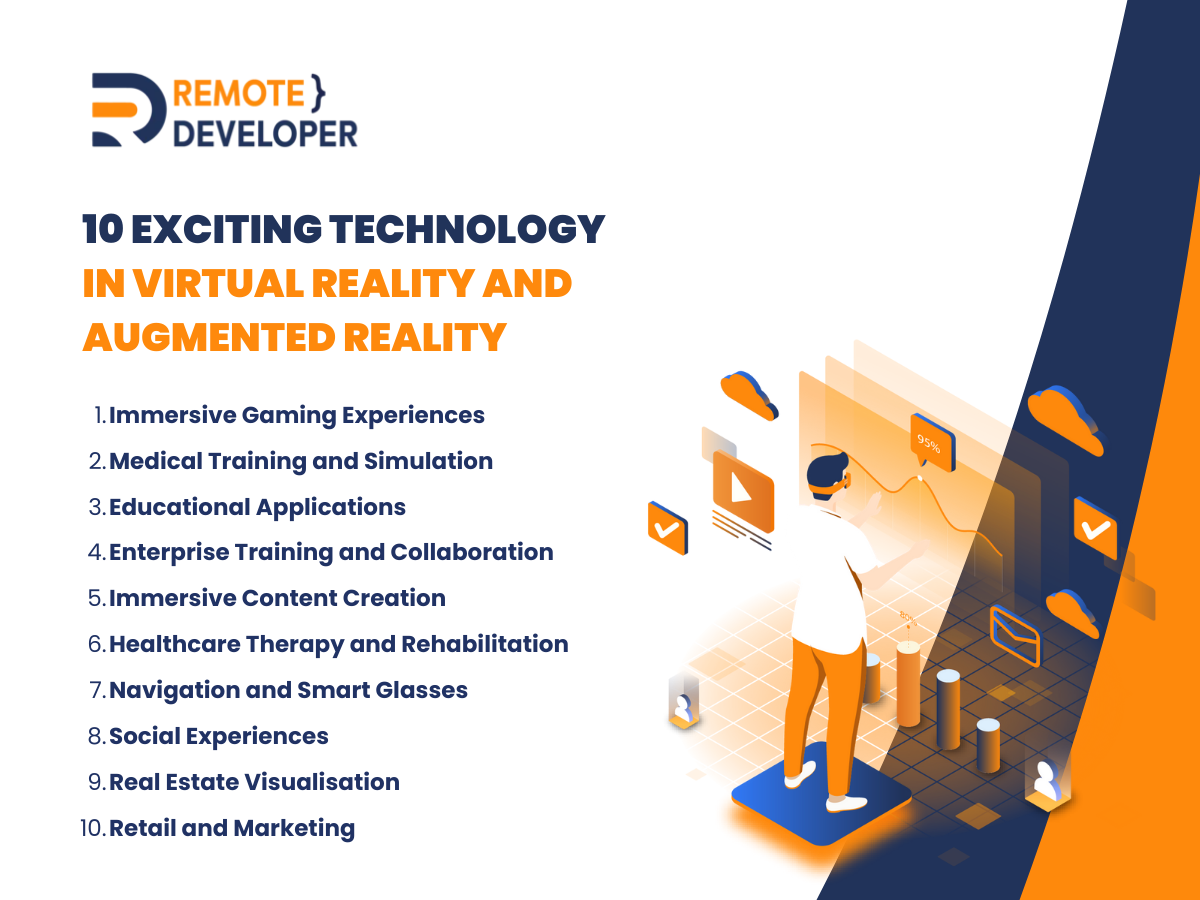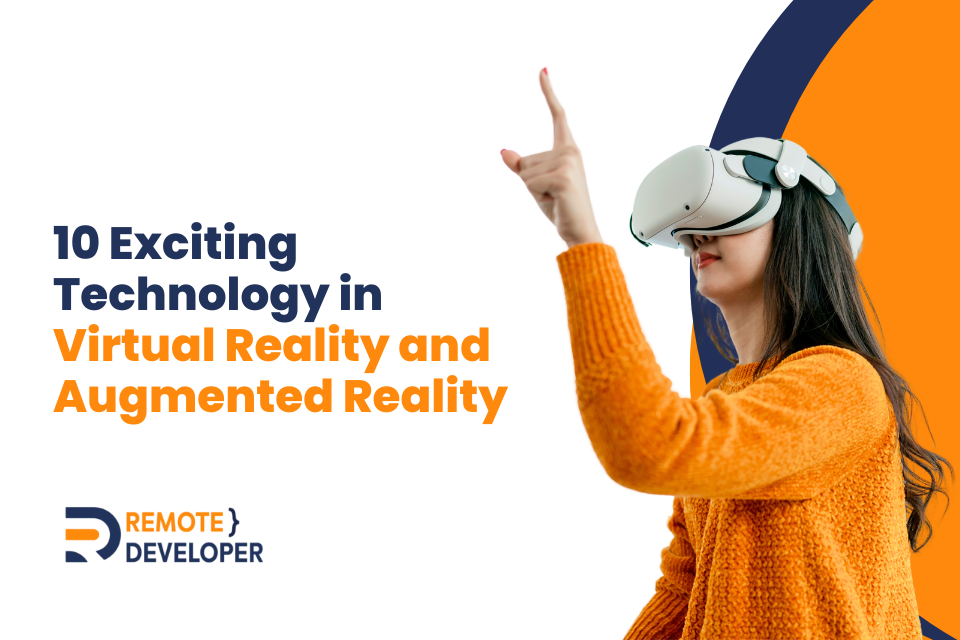In the ever-evolving landscape of technology, VR and AR Technologies stand out as transformative forces, revolutionising how we experience and interact with the digital and physical realms. These immersive technologies have transcended their initial novelty to become integral components in various sectors, from entertainment and education to healthcare and enterprise.
As we delve into VR and AR, this article will explore ten exciting technologies shaping the future and unlocking many possibilities across different domains. From immersive gaming experiences to ground-breaking applications in healthcare and enterprise, join us on a journey through the cutting-edge innovations that define the dynamic world of VR and AR.
What is Virtual Reality (VR) and Augmented Reality (AR)?
Virtual Reality (VR) and Augmented Reality (AR) are two cutting-edge technologies that have revolutionised how we perceive and interact with the world.
Virtual Reality is an immersive experience that transports users to a simulated environment completely separate from their physical surroundings. By wearing a VR headset, users can be fully immersed in a digital world, where they can explore and interact with objects and environments as if they were real.
On the other hand, Augmented Reality overlays digital information into the real world, enhancing our perception of reality. AR technology allows users to see virtual elements integrated into their actual environment through devices like smartphones or smart glasses. This technology has applications in various fields such as gaming, education, healthcare, and everyday tasks like navigation.
Why are these technologies necessary today?
The use cases for VR and AR are vast and continue to expand rapidly. From gaming experiences that transport players into virtual realms to training simulations for professionals in industries such as medicine or aviation, these technologies offer a wide range of benefits, including:
- Provides immersive experiences. Individuals can engage in interactive and lifelike experiences by blending virtual elements with the natural world through AR or creating entirely virtual environments with VR. This level of immersion has profound implications for industries such as gaming, entertainment, education, healthcare, and even marketing.
- Offers new ways of learning. AR and VR have proven to be powerful tools for enhancing learning. Educators can facilitate a more engaging and effective learning process by creating simulated scenarios and interactive simulations through these technologies. Students can explore historical events first-hand or conduct complex scientific experiments in a safe virtual environment.
- Improves productivity. AR and VR also transform industries such as architecture and design by allowing professionals to visualise projects before they are built. This saves time and reduces costs by identifying potential issues early on.
- Enhances user experiences. AR and VR provide immersive and interactive experiences, revolutionising how users engage with digital content and making it more compelling and memorable.
- Increases accessibility. These technologies enhance accessibility by providing solutions for people with disabilities, offering new ways for individuals with visual or auditory impairments to interact with the digital world.
10 Exciting Technologies in Virtual Reality and Augmented Reality
As VR and AR evolve and become more accessible, they hold immense potential for transforming industries across sectors. Whether it’s revolutionising entertainment experiences or how we learn and work, these technologies are unprecedentedly shaping the future of human interaction with digital content.
Here are some examples of the latest technologies in VR and AR.

1. Immersive Gaming Experiences
One of the most well-known applications of VR technology is in gaming. The gaming industry continues pushing VR’s boundaries, creating visually stunning and emotionally engaging experiences.
Today, VR and AR Technologies AR provide immersive experiences to gamers through Immersive gaming experiences. VR headsets, like Oculus Rift and HTC Vive, offer lifelike environments, while AR enhances real-world settings with interactive elements. Likewise, motion controllers add a physical dimension to gaming, making it a truly immersive experience.
This offers players a whole new level of engagement and realism.
2. Medical Training and Simulation
VR and AR have revolutionised medical training by providing realistic simulations for students and professionals. Surgeons, for example, can practice complex procedures in a virtual environment before stepping into an operating room. This enhances their skills and reduces the risk associated with real-life surgeries.
Likewise, AR is also utilised in medical procedures, providing information during operations. Medical students can explore the human anatomy in a three-dimensional space, gaining a deeper understanding of complex structures and their interconnections. This technology facilitates collaborative learning, enabling students and professionals from different locations to engage in virtual medical training sessions.
3. Educational Applications
VR and AR Technologies are revolutionising education by creating interactive and engaging learning experiences. Students can explore historical events, travel to different countries, or even dive into the microscopic world of cells from their classrooms. VR headsets provide a sense of presence, making lessons more engaging and memorable.
AR, on the other hand, enhances the real-world environment by overlaying digital information. Educational apps use AR to provide interactive lessons, allowing students to manipulate 3D models or conduct virtual experiments. These technologies bridge the gap between theoretical knowledge and practical application, making learning more interactive and enjoyable.
4. Enterprise Training and Collaboration
Businesses are leveraging VR and AR Technologies for employee training and collaboration. Virtual simulations can replicate real-world scenarios, allowing employees to practice skills and decision-making in a risk-free environment. This is particularly beneficial in industries such as manufacturing, where workers can familiarise themselves with equipment and procedures before entering the production floor.
AR is being used to enhance collaboration among remote teams. Likewise, it enables real-time communication and data sharing by overlaying digital information with the physical world. Workers can receive instructions, view schematics, or troubleshoot issues without being physically present, improving efficiency and reducing downtime.
5. Immersive Content Creation
VR and AR Technologies are both consumption mediums and powerful tools for content creation. Artists, designers, and filmmakers can use VR to create immersive experiences and explore new storytelling techniques. Virtual worlds provide a canvas for creativity, allowing content creators to build environments that transcend the limitations of traditional media.
With VR sculpting tools and 360-degree filmmaking capabilities, artists can immerse audiences in their creations. This opens up new possibilities for storytelling, art, and design, pushing the boundaries of what is possible in the digital realm.
6. Healthcare Therapy and Rehabilitation
Beyond training, VR is making significant strides in healthcare therapy and rehabilitation. VR therapy is being used to treat conditions such as anxiety, PTSD, and phobias by exposing patients to controlled virtual environments. This controlled exposure helps individuals confront and overcome their fears in a safe and supportive setting.
In rehabilitation, VR offers engaging exercises to aid physical recovery. Patients recovering from injuries or surgeries can perform virtual exercises that mimic real-world movements, making rehabilitation more enjoyable and effective.
7. Navigation and Smart Glasses
AR enhances navigation with features like heads-up displays (HUDs) in cars and smartphones. Smart glasses, equipped with AR technology, overlay digital information onto the user’s field of view. This can include turn-by-turn navigation, points of interest, and real-time data about the environment.
These devices are handy for pedestrians and cyclists, providing navigation instructions without looking at a smartphone. Additionally, AR navigation can enhance experiences in museums, historical sites, and tourist attractions by delivering contextual information directly within the user’s line of sight.
8. Social Experiences
VR and AR Technologies are not just about solitary experiences; it’s also about connecting people in virtual spaces. Social VR platforms allow users to meet and interact with others worldwide in shared virtual environments. Platforms like VRChat and Facebook Horizon enable users to socialise, play games, and attend events in a virtual world.
Social AR experiences extend into everyday life, with applications like Snapchat and Instagram incorporating AR filters and effects for users to enhance and share their moments. These technologies blur the lines between physical and digital interactions, creating a more interconnected world.
9. Real Estate Visualisation
VR and AR are transforming the real estate industry by providing innovative visualisation tools. Virtual property tours allow potential buyers to explore homes and buildings without being physically present. VR headsets offer a realistic sense of scale and space, enabling users to virtually walk through properties and assess details before making decisions.
AR is used in real estate apps to provide additional information about properties when users point their smartphones at buildings or locations. This augmented information can include property details, pricing, and historical data, enhancing the decision-making process for buyers and investors.
10. Retail and Marketing
Retailers leverage VR and AR technologies to enhance the shopping experience and engage customers. VR allows customers to virtually try on clothing and accessories or even experience products before purchasing. This reduces the need for physical try-ons and adds a fun and interactive element to the shopping process.
AR is widely used in marketing campaigns to create interactive and memorable experiences. Brands use AR apps to allow customers to visualise products in their own space using smartphones or tablets. From trying on virtual makeup to placing furniture in a room before buying, AR and VR Companies are reshaping the way consumers interact with brands and make purchasing decisions.
Conclusion
Virtual and Augmented Reality has come a long way from niche technologies to becoming integral parts of various industries. From revolutionising gaming experiences to transforming healthcare, education, and beyond, VR and AR continue to push the boundaries of what is possible.
As technology advances, we can expect even more exciting developments in the immersive and augmented realms, ushering in a new era of possibilities for individuals and businesses alike. Whether it’s creating art in virtual worlds, training for high-stakes scenarios, or revolutionising how we shop, the impact of VR and AR is set to reshape the way we perceive and interact with the world around us.
If you’re eager to stay at the forefront of the latest VR and AR innovations or curious about how these technologies can substantially benefit your business, contact Remote Developer. Our team is here to provide insights, answer your queries, and explore the tailored solutions that align with your unique needs.

